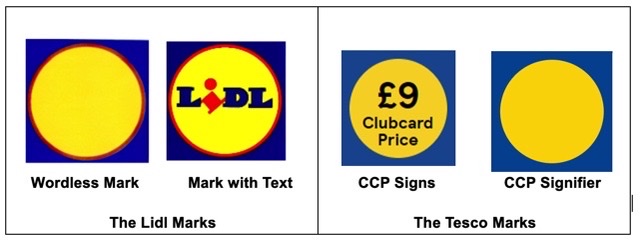This post is the first of four looking at the decision of Smith J in Lidl & another v Tesco & another [2023] EWHC 873 (Ch). It will focus on the s.10(3) trade mark infringement elements of the judgment and the potential impact this may have for rights holders.
The Court’s findings:
- of copyright infringement by Tesco (including the adverse inference drawn by Smith J following Tesco’s decision not to include evidence from its design agency);
- of passing off against Tesco, based on Tesco’s misrepresentation that its goods were of equivalent price to Lidl’s, rather than confusion between the marks; and
- against Lidl for the bad faith registration and attempted “evergreening” of its Wordless Mark,
are also noteworthy and will be explored in the remaining series.
Background
Lidl recently alleged that Tesco’s use of a graphical device of a blue square background and a yellow circle for its Clubcard scheme amounted to s.10(3) TMA infringement of its marks (the “Lidl Marks”) – taking unfair advantage of the reputation developed in the Lidl Marks, as a “discounter” supermarket that offers value. It further alleged copyright infringement and passing off.

Tesco, in response, counterclaimed that some of the Lidl Marks were invalid on the grounds of bad faith, non-use and lack of distinctive character.
Trade Mark Infringement
The CCP Signs and the Lidl ’Mark with Text’ were held to be sufficiently similar when considered from the point of view of an average consumer. Despite the significant difference between the words “Tesco” and “Lidl” used on the marks, it was held that these differing texts did not have the effect of ‘extinguishing the strong impression of similarity conveyed by their backgrounds in the form of the yellow circle, sitting in the middle of the blue square’.
The substantial evidence put forward by Lidl was held sufficient to establish a link between the Mark with Text and the CCP Signs, with both origin and price match confusion/association found. There was no finding of a subjective intention on behalf of Tesco to deliberately take unfair advantage or ‘free-ride’ on Lidl’s reputation, as Tesco had simply been promoting its own agenda, but this is not necessary for a finding of s.10(3) infringement.
Smith J held that use of the CCP Signs had resulted in detriment to the distinctive character of the Mark with Text, as evidenced by the fact that Lidl had been forced to take ‘evasive’ action in the form of corrective advertising. Tesco was further held to have taken unfair advantage of the reputation in the Lidl Marks for low-priced value.
Tesco subsequently failed to establish due cause through its argument that it had the right to use a combination of yellow and blue colours, as yellow was commonly used by supermarkets as bright, attention-grabbing signage and blue is its own livery colour. This argument did not satisfy the Judge, however, who stated that it was those characteristics used in combination that are specific to the Lidl Marks. As such, Tesco was found to have infringed the Mark with Text pursuant to s.10(3) TMA, with this finding repeated in all material respects for the Wordless Mark also.
Conclusion
Whilst this was not a lookalike claim per se, this judgment is helpful to rights holders for a number of reasons, not least the fact that Lidl, as a serial packaging copyist itself, may end up having its own positive court judgment used against it in the future. Indeed, Smith J’s findings that colour and shape were key features of the Lidl Marks, with the “Lidl” word being less of a differentiator, are invaluable to those pursuing lookalike claims and support the conclusions of a recent behavioural science literature review commissioned by Stobbs on the Psychology of Lookalikes. This is good news for FMCG brands and something of an own goal for Lidl.
This case is also a lesson in streamlining your claim from an early stage, with around £2.35 million being spent in legal fees, with Lidl having run several different claims in parallel, requiring substantial evidence to be put forward by both sides. Lidl could have been “Lidl on price” if it simply had confined its pleaded case to s.10(3) TMA infringement, relying only upon the plethora of social media evidence gathered to achieve the same result.
_____________________________
To make sure you do not miss out on regular updates from the Kluwer Trademark Blog, please subscribe here.
Kluwer IP Law
The 2022 Future Ready Lawyer survey showed that 79% of lawyers think that the importance of legal technology will increase for next year. With Kluwer IP Law you can navigate the increasingly global practice of IP law with specialized, local and cross-border information and tools from every preferred location. Are you, as an IP professional, ready for the future?
Learn how Kluwer IP Law can support you.


